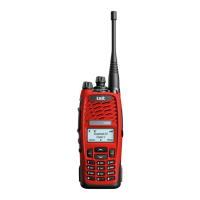106 Operating in conventional mode
4 Press Select.
5 Press the scroll keys to select the new priority
channel.
6 Press OK.
If successful, the message P1 channel changed or
P2 channel changed appears.
To check the new group details, press Back
and select the Group members menu option.
The new priority channel has the or icon
next to it.
Icon and messages that may appear when
changing group details
The following icons may appear when viewing group
membership details, adding or deleting channels from
a group, or changing a group’s transmit or priority
channels.
Icon Meaning
This channel is used to transmit on when there has
been no recent activity. You cannot delete this
channel (it will not appear under Delete channel).
This channel is the group’s first priority channel. You
cannot delete this channel (it will not appear under
Delete channel).
This channel is the group’s second priority channel.
You cannot delete this channel (it will not appear
under Delete channel).
There is more than one instance of this channel in
the group (the channel will be scanned more often).
If you delete this channel, the radio will attempt to
delete all instances of the channel.

